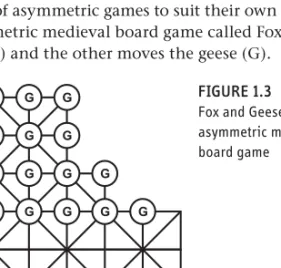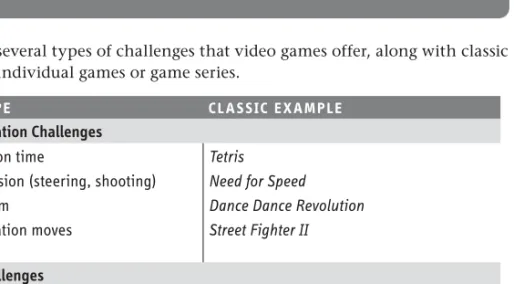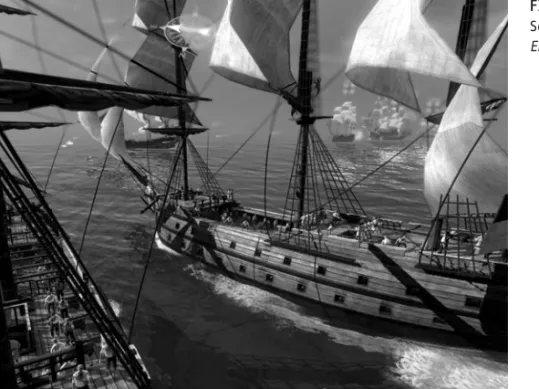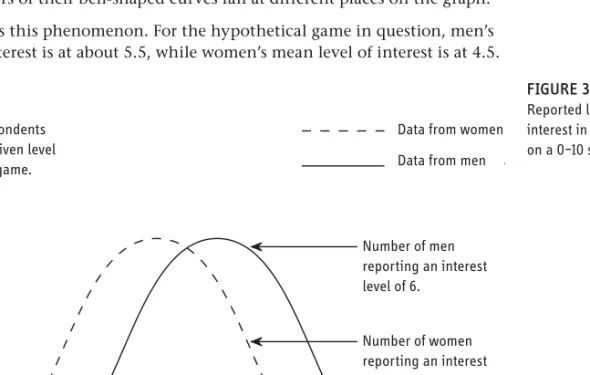Suggestions, corrections and even complaints are always welcome; please send them to [email protected]. Welcome to Fundamentals of Game Design, Second Edition – an updated version of the original Fundamentals of Game Design, which itself was based on an earlier book called Andrew Rollings and Ernest Adams on game design.
Who Is This Book For?
How Is This Book Organized?
The game consists of the challenges the player faces and the actions he takes to overcome them. The second half of the chapter addresses the special problems of persistent worlds such as World of Warcraft.
Companion Web Site
It also describes various aspects of design in the commercial environment, including documents used and work roles. The remaining chapters of Part One are devoted to specific aspects of video games that you will encounter when designing them.
PART ONE
Then we discuss what computers mean for gaming and how video games differ from conventional games. In English we use the word play to describe how we entertain ourselves with toys, puzzles and games, although with puzzles we more often say that we solve them.
OTHER VIEWS
Defining any term that refers to a broad class of human behavior is a tricky business, because if one can find a single counterexample, the definition is imprecise. In the next few sections, we will take a closer look at each of these elements and their meaning in the definition.
PLAY
The definition refers to each of these elements and includes some additional terms.
PRETENDING
THE MAGIC CIRCLE
If the events in the game also have meaning in the real world, the magic circle fades away. If so, then the game was literally a matter of life and death – a matter of great importance in the real world.
A GOAL
The game process may or may not be an inherent part of the game itself. The goal of the game is defined by the rules and is arbitrary because the game designers can define it however they want.
THE RULES
If conflicts are likely to arise, the rules should include a measure to determine which rule prevails. For example, Rules of Play (Salen and Zimmerman, 2003, p. 80) describes a game as an “artificial conflict”. Although this concept is central to game theory, it is too restrictive a definition for our purposes because it excludes creative games and purely cooperative games.
CHALLENGES
ACTIONS
THE DEFINITION OF GAMEPLAY
In order for all players to enjoy the game, everyone must agree on what constitutes fair play.
CHANGING THE RULES
WHO GOES FIRST?
I AM MY OWN TYPICAL PLAYER
You may also find yourself starting to like a game you didn't think you would while you're working on designing it!). Insisting that you have to have passion for your game or you can't do a good job at it is a very self-centered approach - the opposite of player-centered design.
THE PLAYER IS MY OPPONENT
Core mechanics also determine the effect of the player's actions on the game world. The user interface mediates between the basic game mechanics and the player (see Figure 2.1).

INTERACTION MODELS
CAMERA MODELS
If a game doesn't have a virtual space (for example, if it's a business simulation that's mostly about money), the term camera model doesn't apply, and you need to explain your screen layout in your design documents in more detail. a lot of detail. The most commonly used camera models are first-person and third-person for rendering 3D game worlds, and top-down, side-scrolling, and isometric for rendering 2D worlds.
GAMES WITHOUT GRAPHICS
Because the game only offers a subset of all its challenges and actions in a given gameplay mode, the player is focused on a limited number of objectives. When either the gameplay available to the player or the user interface (or both) changes significantly, the game has left one state and entered another.
GAMEPLAY MODES IN AMERICAN FOOTBALL
The game's gameplay modes and shell menus and the relationships between them together make up the game's structure. To document the structure, you can start by making a list of all modes and menus in the game.
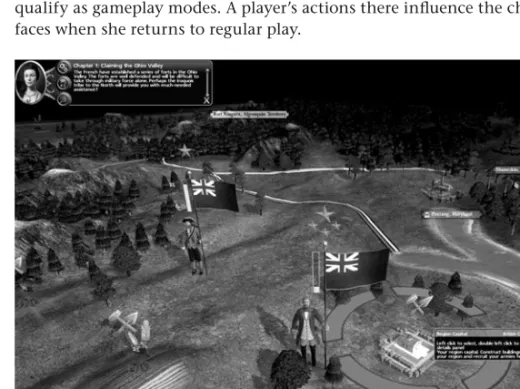
CONCEPT VERSUS PREPRODUCTION
GETTING A CONCEPT
DEFINING AN AUDIENCE
DETERMINING THE PLAYER’S ROLE
FULFILLING THE DREAM
THE DANGER OF IRRESOLUTION
DEFINING THE PRIMARY GAMEPLAY MODE
DESIGNING THE PROTAGONIST
DEFINING THE GAME WORLD
DESIGNING THE CORE MECHANICS
CREATING ADDITIONAL MODES
DESIGNING LEVELS
WRITING THE STORY
BUILD, TEST, AND ITERATE
When the development moves from pre-production to production, the team starts working on the material that will go to the customer, and it must be manufactured with special care. However, you still can't just design something, hand your design over to the programmers, and forget about it.
GAME DEVELOPMENT/SCRUM MANAGEMENT PROCESS
This person oversees the overall design of the game and is responsible for ensuring that it is complete and coherent. Writers generally don't do technical writing - that's the responsibility of the game designers.
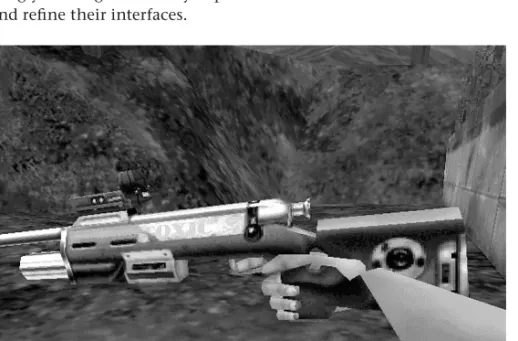
GAME IDEA VERSUS DESIGN DECISION
An important part of game design is communicating the design to other members of the team. As long as you can keep the website secure, this is a good way to document a game design so that all members of the team can access it and you can update it easily.
HIGH CONCEPT DOCUMENT
GAME TREATMENT DOCUMENT
CHARACTER DESIGN DOCUMENT
WORLD DESIGN DOCUMENT
The world design document must also document the "feel" of the world, is aesthetic style and emotional tone.
FLOWBOARD
STORY AND LEVEL PROGRESSION DOCUMENT
THE GAME SCRIPT
The player's roles in the game, if the game is representative enough to have roles. Defining the player's role in the game world is a key part of defining the concept of your game.
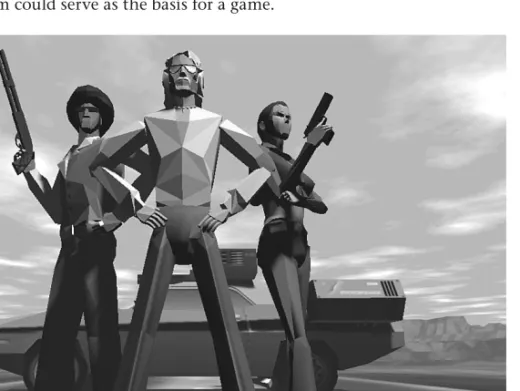
THE PLAYER-CENTRIC PHILOSOPHY AND THE TARGET AUDIENCE
One of the first questions a publisher will ask you is, "Who is going to buy this game?" Think carefully about the answer. You can't make a game for everyone, so your target audience is necessarily a subset of all potential players, a subset determined by your answers to the questions "Who will enjoy this game?" and "What kind of challenges do they like?" As you answer these questions, you may be tempted to assume that people in one category (adult men, for example) are a special audience that has nothing in common with people in other categories (adult women, children, teenagers, etc. ).
REASONING STATISTICALLY ABOUT PLAYER GROUPS
Furthermore, the number of women who report an interest level of 6 is about two-thirds of the number of men who report the same interest level. In other words, two-fifths of all people who report an interest level of 6 are women—far too many to simply ignore.
STRIVE FOR INCLUSIVENESS, NOT UNIVERSALITY
In other genres, such as RPGs and adventure games, the story is a big part of the game's entertainment. Once the game is ready, you must also submit it to the manufacturer for extensive testing before releasing it.
STAND-ALONE GAMES
Fortunately, the Windows and Macintosh operating systems solved many of these problems by isolating the programs from the hardware. Still, games tend to demand more from the machine than other applications, and configuration conflicts still occur.
BROWSER-BASED GAMES
What is the game’s setting? Where does it take place?
Will the game be broken into levels? What might be the victory condition for a typical level?
Does the game have a narrative or story as it goes along? Summarize the plot in a sentence or two
In fact, gameplay in most single-player video games feels to the player like an interaction between them and the game world. The game world is an artificial universe, an imaginary city in which the events of the game take place.
ART IS NOT ENOUGH
When the player enters the magic circle and pretends to be somewhere else, the game world is the place she pretends to be. As a general rule, the more a player understands a game's core mechanics, the less the game world matters.
SPATIAL DIMENSIONALITY
For example, the Legacy of Kain series presents two versions of the same 3D world, the Spectral Realm and the Material Realm, with different gameplay modes for each. Like anything else you design, the dimensionality of your physical space should serve the entertainment value of the game.
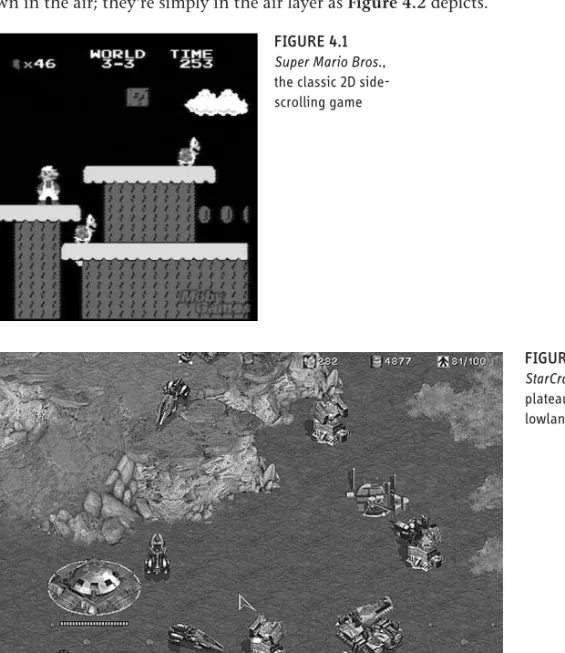
SCALE
To solve this problem, the game simply does not include tall buildings or hills and exaggerates the height of the people. The scale of the town should be small enough that it only takes the character a few minutes to get from one end to the other, unless the goal of the game is to explore a richly detailed urban environment.
BOUNDARIES
Everything in the world idles or runs in a continuous loop until the player interacts with the game in some way. In some games, time is implemented as part of the game world, but not part of the gameplay.

VARIABLE TIME
Occasionally, the player is pressured by being given a limited amount of time in the real world to accomplish something, but this usually only applies to a single challenge and is not part of a larger notion of time in the game. At night, the shops are closed and the characters in the game are at risk of being attacked by the wandering monsters.
ANOMALOUS TIME
But when all the characters go to sleep, the game speeds up significantly, letting hours pass in seconds. The game runs something like 48 times as fast as real life, so it takes about 20 minutes of real time to play through the 16 hours of game world daylight.
LETTING THE PLAYER ADJUST TIME
The environmental characteristics of the game world form the basis for the creation of its art and audio. We will look at two particular properties: the cultural context of the world and the physical surroundings.
CULTURAL CONTEXT
The setting of a game is the imaginary history, either large scale (nations, wars, natural disasters) or small scale (personal events and interactions), that preceded the time in which the game takes place. A game set in your own culture can simply use the things you see around you.
PHYSICAL SURROUNDINGS
The physical environment plays a large role in setting the tone and mood of the game as it is played, whether it is the quiet joy of Mario or the harsh realities of the Godfather series (see Figure 4.10). Stanley Kubrick listened to hundreds of records to choose the music for 2001: A Space Odyssey, and he stunned the world with his choice of "The Blue Danube" for the ship's docking sequence.
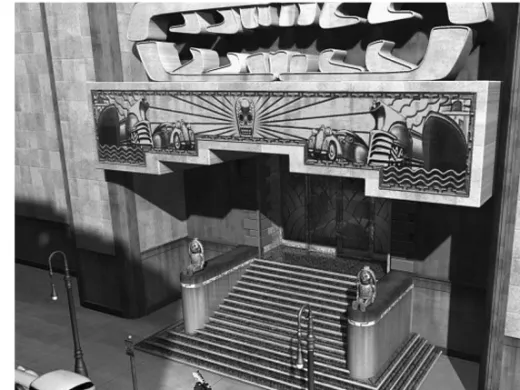
DETAIL
If the player is having trouble taking care of everything you've given them, the game is probably too detailed. The player in a war game cannot delegate tasks to intelligent subordinates, so numbers must be kept to a size he can reasonably handle.)
DEFINING A STYLE
OVERUSED SETTINGS
SOURCES OF INSPIRATION
It's tempting to borrow from our nearest visual neighbor, the movies, because the filmmakers have already done the visual design work for us. In terms of the richness of their emotional content, games are now about where the movies were when they moved from the Nickelodeon to the screen.
INFLUENCING THE PLAYER’S FEELINGS
The fate of the world is not necessarily at stake; it is the destinies of Rick, Ilsa and Victor that tug at our hearts. Don't make your play about the fate of the world if you're serious about creating an emotional resonance with your audience; the destiny of the world is too great to comprehend.
THE LIMITATIONS OF FUN
Many games take danger to hyperbolic levels with extreme claims like "The fate of the universe is in your hands!" Such hyperbole appeals to young people, who often feel powerless and have fantasies of power. At the end of Casablanca, Rick said, “Three little people's troubles aren't worth a hill of beans in this crazy world,” but he was wrong.
YOU CAN’T PAINT EMOTION BY NUMBERS
Games allow, even require, you to do things you can't do in the real world. The range of actions allowed in the game world is typically narrower than in the real world (you can fly your F-15 fighter all you want, but you can't get out of the plane), but often the allowed actions are quite extreme: killing people, stealing things and so on.
MORAL DECISION-MAKING
In some ways, the morality of a game world is part of its culture and history, which are part of the environmental dimension, but because the ethical dimension poses special design issues, it needs a separate discussion. The ethics of most game worlds differ slightly from those of the real world – sometimes they are completely reversed.
THE PECULIAR MORALITY OF AMERICA’S ARMY
A WORD ABOUT GAME VIOLENCE
As you design elements of the game, you'll need to ask yourself how much realism you want to include. Again: Every design decision you make must serve the entertainment value of the game.
PHYSICAL DIMENSION
If you've done this thoroughly, your game world will be one that the player can immerse themselves in, a consistent fantasy that they can believe in and enjoy being a part of. Choose one of the following game genres and then choose a famous painter, photographer or filmmaker and a famous composer or musician whose work you would like to use to create the appropriate emotional tone for your game.
TEMPORAL DIMENSION
ENVIRONMENTAL DIMENSION
If there are no people in the game, what is there instead, what do they look like and how do they act.
EMOTIONAL DIMENSION
ETHICAL DIMENSION
Since the avatar represents the player in the game world, these activities are called self-defining play. Avatar selection allows the player to choose from a number of predefined avatars, usually at the start of the game.
FUNCTIONAL ATTRIBUTES
Customization can occur both at the start of the game and through upgrades awarded or purchased as the game progresses. These strengths and weaknesses in turn determine how the player should play with the character to be successful in the game: to take advantage of the strengths and to avoid situations in which the weaknesses make the player vulnerable.
COSMETIC ATTRIBUTES
You can also offer this right explicitly as a cheat feature of the game, so players will know they are getting an unusual advantage. Dungeons & Dragons provides one of the most popular examples of player-adjustable functional attributes, but many, many games use them.
SHOULD SEX BE A FUNCTIONAL
Allow players to earn the right to set their character's functional attributes in any way they want by first completing a game with limited attributes. First-person shooters usually give the player a choice of weapons, and when a player chooses a sniper rifle over an assault rifle, it says something important about their character and how they're going to play the game.
ATTRIBUTE OR A COSMETIC ATTRIBUTE?
A computer game necessarily limits creative play to the domain that the game supports: painting, music composition, animation, and so on. If the player is allowed to create only within artificial limitations imposed by the rules, her activity is called limited creative play.
PLAY LIMITED BY AN ECONOMY
CREATING TO PHYSICAL STANDARDS
Every element of the theme park costs money and the player must stay within a budget. RollerCoaster Tycoon 2 includes a feature to show the player how high and how steep the different segments of the roller coaster are, so they can figure it out with a little experimentation.
CREATING TO AESTHETIC STANDARDS
These games allowed the player to build games that he or someone else could play. Generally, though, a good level editor lets the player construct an entirely new landscape, place challenges in it, and write scripts that the game engine can run.
DANGERS OF ALLOWING MODS
The nature of the player's relationship with the avatar varies considerably from game to game. The way a player feels about an avatar depends somewhat on how the player controls the avatar in the game.
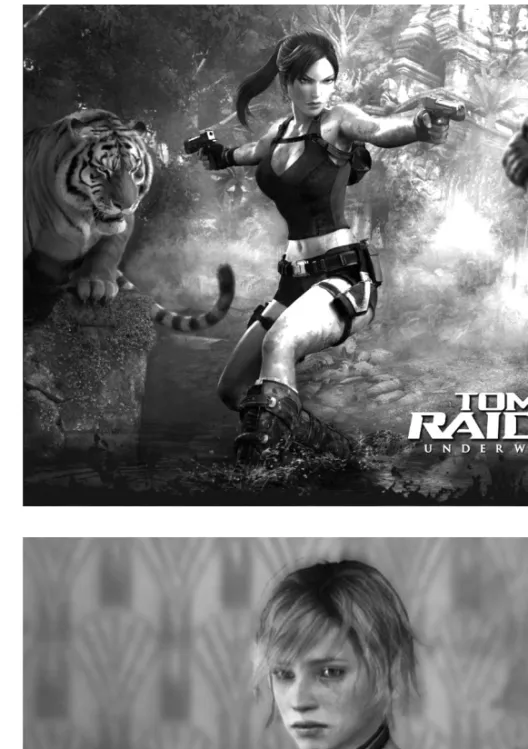
HUMANOIDS, NONHUMANOIDS, AND HYBRIDS
The exceptions are non-specific avatars who view the world only from a first-person perspective (such as Gordon Freeman) and disembodied characters who sometimes talk to the character (via headphones, telepathy, or other means) but are never seen. Story-driven character design, an alternative to art-driven, is defined in the section that follows.
CARTOONLIKE QUALITIES
Davros, the creator of the Daleks, has a human torso and head, but a mechanical lower half. Animations for a stupid character in a game sometimes include the stupidity, as long as it doesn't affect the player's experience of the play.
COOL WITHOUT ATTITUDE
HYPERSEXUALIZED CHARACTERS
Kratos, from the God of War games, typifies the hypersexualized male character, as do most of the male characters in fighting games. You might get away with it if it's purposely done for fun; Putting Cate Archer in a retro 1960s catsuit worked well for the designers of No One Lives Forever because of the game's humorous context.
CONCEPT ART AND MODEL SHEETS
What sorts of sounds will each character in your game make? What sorts of music are appropriate for them? How will your choices of sounds and music sup-
How the character's grammar, vocabulary, tone of voice, and speech patterns contribute to the player's understanding of the character.
How do the character’s grammar, vocabulary, tone of voice, and speech patterns contribute to the player’s understanding of the character?
Game designers add stories to increase a game's entertainment value, to keep the player interested for a long game, and to help sell the game to potential customers. However, your publisher's marketing department can depict characters and situations from your game's story and even print part of the story itself in their promotional materials.
THE GREAT DEBATE
Based on that, a few people would say that every game has a story because the action of the game can be described afterwards. The description of a Tetris game would be an extremely uninteresting story due to the endless repetition of the game and the lack of emotional content beyond the player's own feelings.
REQUIREMENTS OF GOOD STORIES
To be dramatically significant, the story's events must involve something, or preferably someone, that the listener cares about. The story should be constructed in such a way that it encourages the listener to take an interest in, and preferably identify with, one or more of the story's characters.
INTERACTIVE STORIES
A story can be interactive even if the player's actions cannot change the direction of the plot. When the player overcomes a challenge, the game responds with the next event in the story.
THE ROLE OF NARRATIVE
In an interactive story, narrative is the part of the story that you, the designer, tell your player—as opposed to those actions the player performs, or those events that create the core mechanics. N A R R AT I V E The term narrative refers to story events that are told to the player through the game - that is, told or shown.
COMMONLY USED NARRATIVE BLOCKS
For example, the game Half-Life begins with a cutscene in which Gordon Freeman, the player's avatar, takes a tram ride through the Black Mesa research complex while a voice explains why he is there. Cutscenes during gameplay, on the other hand, should be shorter because they break the flow and rhythm of the player's actions.
BALANCING NARRATIVE AND GAMEPLAY
DRAMATIC TENSION
GAMEPLAY TENSION
THE FALSE ANALOGY
Note that a double-headed arrow labeled Triggers connects the story engine to the core mechanics in Figure 7.1. If, for example, the player makes a key decision that will affect the story later, the core mechanics inform the story engine of the decision.
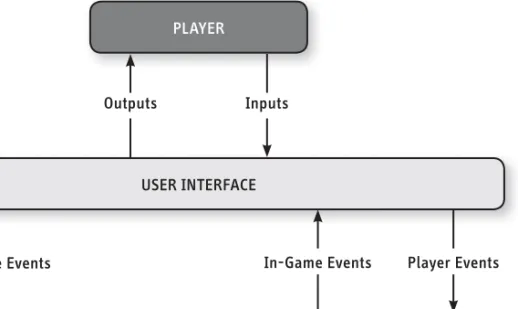
IMMEDIATE, DEFERRED, AND CUMULATIVE INFLUENCE
Branch points associated with player decisions have a branch for each option you offer the player. If a trivial decision has a profound consequence, the player will feel cheated: He did not know that the decision mattered and had no reason to expect that it would matter.
THE BRANCHING STORY STRUCTURE
Attaching significant consequences to trivial decisions violates the requirement that stories be believable and make dramatic sense. The Hitchhiker's Guide to the Galaxy, a text adventure, did this for comic and ironic purposes, but most players and critics judged it to be an extremely difficult game for this very reason: The player could not predict which to be the consequences of his actions. to be.
START
END 1
The story engine keeps track of the player's position in the story at any given moment. The player can choose one of several different characters as their avatar, and this choice can determine where the story begins.
DISADVANTAGES OF THE BRANCHING STORY
The player must play the game repeatedly if he wants to see all the content. However, the player can only control the events of the story to the extent that they can control the core mechanics through their play.
CHARACTER-AGNOSTIC PLOTS AND KING OF DRAGON PASS
King of Dragon Pass is different because instead of the player going to find adventure, the adventures come to her. However, the player's desire for an outcome that reflects his actions varies somewhat depending on what those actions were.
PREMATURE ENDINGS DON’T COUNT!
CHALLENGES AND CHOICES
WHEN TO USE MULTIPLE ENDINGS
